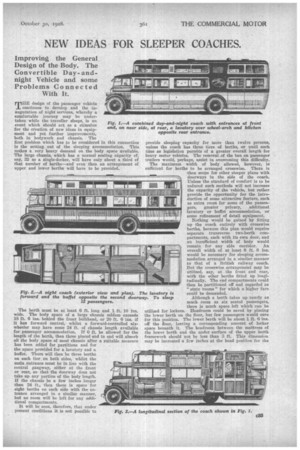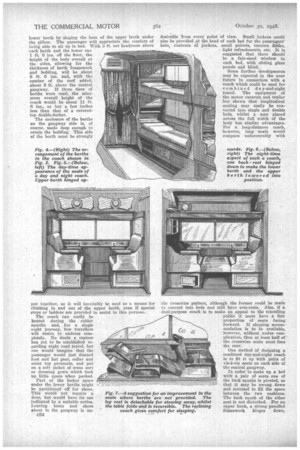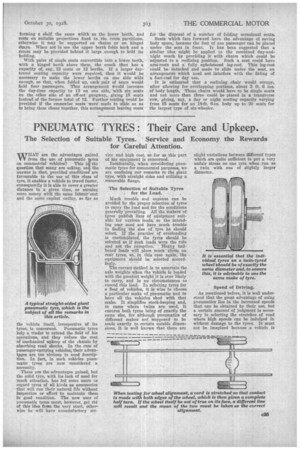NEW IDEAS FOR SLEEPER COACHES.
Page 41

Page 42

Page 43

If you've noticed an error in this article please click here to report it so we can fix it.
Improving the General Design of the Body. The Convertible Dayandnight Vehicle and some Problems Connected
T'
+ design of the passenger vehicle continues to develop and the inauguration of night services, whereby a comfortable journey may be undertaken while the traveller sleeps, is an event which should net as a stimulus for the creation of new ideas in equipment and yet further improvements, both in bodywork and chassis. The
first problem which has to be considered in this connection is the setting out of the sleeping accommodation. This makes a very heavy demand on the body space available. The large chassis, which has a normal seating capacity of, say, 32 as a single-decker, will have only about a third of that number of berths—andeven then an arrangement of and lower berths will have to be provided.
upper It will be seen, therefore, that under present conditions it is not possible to provide sleeping capacity for more than twelve persons, unless the coach has three tiers of berths, or until such time as legislation perniits of a greater overall length for heavy motor vehicles. The removal of the ban on passenger trailers would, perhaps, assist in overcoming this difficulty.
The maximum width of body allowed, however, is sufficient for berths to be arranged crosswise. There is .then scope for other sleeper plans with doorways in the side of the coach. Unless the standard of comfort is to be reduced such methods will not increase the capacity of the vehicle, but rather provide the opportunity for the introduction of some attractive feature, such as extra room for some of the passengers, greater privacy, additional lavatory or buffet accommodation, or some refinement of detail equipment.
IF glint 1, I Nothing would be gained by fitting up the coach entirely with crosswise berths, because this plan would require separate transverse two-berth compartments, each with its own door, and an insufficient width of body would remain for any side corridor. An overall width of at least 8 ft. 6 ins. would be necessary for sleeping accommodation arranged in a similar manner to that of a British railway coach. But the crosswise arrangement may be utilized, say, at the front and rear, with the other berths fitted up longitudinally. The end compartments could then be partitioned off and regarded as " state rooms" for which a higher fare mold be demanded.
Although a berth takes up nearly as much room as six seated passengers, there is much space left which can be utilized for lockers. Headroom could be saved by placing the lower berth on the floor, but few passengers would care for this position. The lower berth will be about 1 ft. 6 ins. off the floor, leaving a corresponding amount of locker space beneath it. The headroom between the mattress of the lower berth and the under surface of the upper berth framework should not be less than 3 ft. This dimension may be increased a few inches at the head position for the
Tower berth by sloping the base of the upper berth under the pillow. The passenger will appreciate the comfort of being able to sit up in bed. With 3 ft. net headroom above cach berth and the lower one 1 ft. 6 ins. off the floor, the height of the body overall at the sides, allowing for the thickness of berth framework and bedding, will be about 8 ft. 6 ins. and, with thin camber of the roof added, about 9 ft. above the central gangway. If three tiers of berths were used, the minimum overall height of the coach would be about 11 ft. 6 ins., or but a few inches less than that of a coveredtop double-decker.
The enclosure of the berths on the gangway side is, of course, made deep enough to retain the bedding. This side of the berth must be strongly
Put together, as it will inevitably be used as a means for climbing in and out of the upper berth, even if special steps or ladders are provided to assist in this purpose.
The coach can easily be heated during the colder months and, for a single night journey, few travellers will desire to undress completely. No doubt a custom ha a yet to be established regarding night road travel, but one would imagine that the passenger. would just discard foot and hat gear, collar and outer top garments, and put on a soft jacket of some sort or dressing gown which took tip little space when packed.
Part of the locker space under the lower berths 'might be partitioned off for shoes. This would not require a door, but would have its use indicated by a suitable notice. Leaving boots and shoes about in the gangway is un
()34 desirable from every point of view. Small lockers could also be provided at the head of each bed for the passengers' hats, contents of pockets, small parcels, vacuum flasks, light refreshments, etc. It is suggested that there should be a fair-sized window to each bed, with sliding glass panels and blind.
Some further developments may be expected in the near future in connection with a coach which could be used for combined da y-and-night travel. The equipment of the motor caravan and trailer has shown that longitudinal seating may easily be converted into single and double beds, whilst a seat placed across the full width of the body has similar advantages. For a long-distance coach, however, long seats would compare unfavourably with the crosswise pattern, although the former could be made In convert into beds and still have arm-rests. Also, if a dual-purpose coach is to make an appeal to the travelling public it' niu-st have a fair proportion of seats facing forward. If sleeping accommodation is to be available, however, without undue complication, then at least half of the crosswise seats must face the rear.
One method of designing a combined day-and-night coach is to fit it up with pairs of vis-d-vis seats on each side of the central gangway.
In order to make up a bed with a pair of seats one of the back squabs is pivoted, so that it may be swung down and reversed to fill the space between the two cushions. The back squab of the ether seat is not disturbed. For an upper bunk, a strong panelled framework hinges down,
li forming a shelf the same width as the lower berth, and rests on suitable projections fixed to the Cross partitions, otherwise it may be supported on chains or on hinged titays. When not in use the upper berth folds back and a recess may be provided behind it large enough to hold its bedding.
With pairs of single seats convertible into a lower berth, with a hinged berth above them, the coach then has a capacity of, say, 12 seats or 12 berths. If a larger daytravel seating capacity were required, then it would be necessary to make the lower berths on one side wide enough, so that, when folded up, each pair of seats would hold four passengers. This arrangement would increase the day-time capacity to 12 on one side, with six seats on the ather side of an off-set gangway, giving 18 seats instead of the former total of 12. Further seating could be provided if the crosswise seats Were 'made to slide so as to bring them closer together, this arrangement leaving rooni
for the disposal of a number of folding occasional seats.
Seats which face forward have the advantage of saving body space, because the feet of one passenger can be placed under the seat in front. It has been suggested that a similar idea might be applied to the combined day-andnight eau& by providing it with chairs which could be adjusted to a reclining positian. Such a seat could have aehi-rests and a. fully upholstered leg-rest. This leg-rest could be. detached and made to slide under the seat, an airtmgement which need not interfere with the fitting of a foot-rest for day use.
It is estimated that a reclining chair would occupy, after allowing for overlapping portions, about 3 ft. 6 ins. of body length. These chairs would have to be single seats and not more than three could be placed in a transverse ro*, giving, say, .a day or night seating capacity varying from 13 sea& for an 18-ft. 8-in, body up to 20 seats for the largest type of six-wheeler.


















































